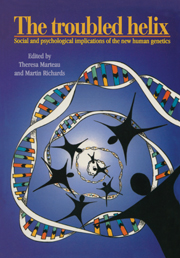Book contents
- Frontmatter
- Contents
- List of contributors
- Preface
- Preface to the paperback edition
- Acknowledgements
- Part I Personal stories
- Part II Clinical context
- Part III Social context
- 9 The troubled helix: legal aspects of the new genetics
- 10 Human pedigree and the ‘best stock’: from eugenics to genetics?
- 11 Public understanding of the new genetics
- 12 Families, kinship and genetics
- 13 Ethics of human genome analysis: some virtues and vices
- 14 Genetics and racism
- 15 Predictive genetics: the cultural implications of supplying probable futures
- 16 The new genetics: a feminist view
- 17 Afterword
- Index
15 - Predictive genetics: the cultural implications of supplying probable futures
from Part III - Social context
Published online by Cambridge University Press: 01 June 2011
- Frontmatter
- Contents
- List of contributors
- Preface
- Preface to the paperback edition
- Acknowledgements
- Part I Personal stories
- Part II Clinical context
- Part III Social context
- 9 The troubled helix: legal aspects of the new genetics
- 10 Human pedigree and the ‘best stock’: from eugenics to genetics?
- 11 Public understanding of the new genetics
- 12 Families, kinship and genetics
- 13 Ethics of human genome analysis: some virtues and vices
- 14 Genetics and racism
- 15 Predictive genetics: the cultural implications of supplying probable futures
- 16 The new genetics: a feminist view
- 17 Afterword
- Index
Summary
Introduction
The phrase ‘predictive genetic testing’ refers to the examination of a sample of genetic material with the aim of producing information about the health-related future of the person from whom it was taken. Such tests can be carried out on genetic material collected from individuals as fetuses, or as born people of any age. At present, predictive genetic testing has several routine applications in ante-natal care, such as the use of chorionic villus sampling in the early identification of fetuses with chromosomal abnormalities. The use of predictive genetic testing in people already born has, until recently, been restricted to a handful of relatively rare genetic disorders, such as Huntington's disease or muscular dystrophy. This chapter, however, is principally concerned with the extension of predictive testing into a wide range of very common illnesses and conditions, which is being facilitated by current rapid developments in human genetics (Wilkie, 1993).
In ante-natal testing, the process creates the opportunity for prospective parents to make decisions about the termination of an affected fetus, or to be forewarned of the birth of a child with special needs. In individuals already born, predictive genetic testing allows for the early start of therapeutic or prophylactic regimes (if any exist for a given disorder), and for life decisions to be informed in a way that would not otherwise be possible – the decision of someone who has inherited Huntington's disease not to reproduce, for example.
- Type
- Chapter
- Information
- The Troubled HelixSocial and Psychological Implications of the New Human Genetics, pp. 317 - 330Publisher: Cambridge University PressPrint publication year: 1996
- 19
- Cited by

